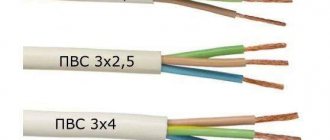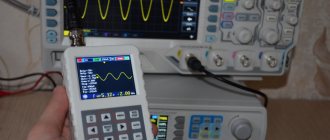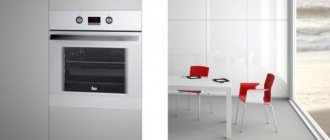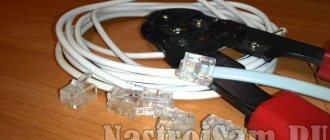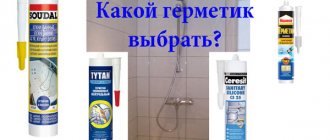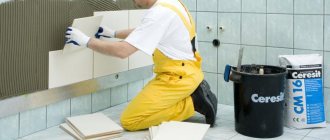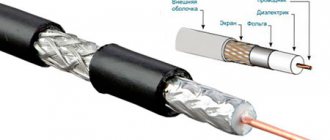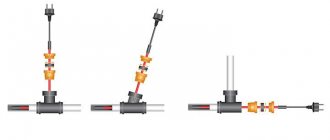To connect the antenna directly to the TV, you only need an antenna cable, which has long been familiar from meter-band receivers (MV, analogue television). Its main task is to transport the signal from the antenna and display the image on the TV. At the same time, all antenna wires have a significant drawback - reduced signal quality. For this reason, you need to responsibly approach the question of how to choose an antenna cable. But before that, you need to know its properties, which are described in this article.
How does a television cable work?
The antenna cable is very different from the usual network wires in that it has a more complex structure and each component must be considered separately. Wires of this structure are called coaxial cables.
Lived
A central wire that resembles a core when cut crosswise. The composition is made of copper or alloys. The first option is preferable for safety reasons - copper is more susceptible to heating and has a high level of thermal conductivity. Consequently, if there is a short circuit or overcurrent is applied to the cable, rapid heating and an increase in resistance will occur, to which the TV fuse will immediately react. Steel alloys in this case will be less effective.
It is also advisable to choose a thicker core (~1 mm), because As the diameter increases, the attenuation coefficient decreases.
Screen
An outer conductor that prevents the signal from being attenuated by propagating outside the cable. Its functions are comparable to that of a satellite dish reflector. Today there are three screen options - foil, aluminum film and wire braid. The latter option for making a screen is less expensive and such cables are the cheapest. However, the outer wire is not solid, which greatly increases the attenuation coefficient. It is possible to use such a cable for digital television only when using an indoor antenna. Significant signal loss is guaranteed when the distance from the receiver to the TV is more than 1 m.
Foil and film are solid screens that reduce the attenuation coefficient to zero. This cable is recommended for connecting terrestrial and satellite television with an outdoor antenna. Foil would be preferable, but remember that it is not flexible and will break if bent too hard. If you choose to install an antenna on the roof of an apartment building, you need a long cable for wiring to the apartment and strong bends are planned, you will have to buy a cable for the most expensive TV, the screen of which consists of foil with a surface braid. In this case, it is used to protect the screen from damage at the bend points.
Shell
Insulating material made from HDPE or PVC. It can be white or black, less often gray. You can choose a cable for TV without being particularly interested in the casing, because... it does not affect the system characteristics of the cable. It is recommended to consider a denser material (since it is less susceptible to wear and heat), but within reasonable limits, because as it increases, flexibility decreases.
Plug
There are two types of plugs on the market: in a single design and in the format of a screw with a nut. In the latter case, it is enough to expose the cable and insert it inside the plug, then tighten it. This method is perfect for those who are not electrically versed and want to quickly connect the antenna wire. If you have the skills to use a soldering iron, it is safer to purchase a plug in a single design and solder the wires.
Cables for satellite and terrestrial digital TV
The digital signal is transmitted in the decimeter wavelength range (UHF), which corresponds to frequencies of 0.3 - 1 GHz (terrestrial TV) and 1 - 3 GHz (satellite TV). The physical characteristics of this signal are very different from those of analog television in the meter (VHF) range - the wave projected onto the receiver has a smaller thickness in diameter. Also, the frequency of arrival (not to be confused with the frequency) of such a signal is higher, so a thicker cable is required.
The optimal characteristics of the antenna cable will be:
- core thickness 0.3 - 1 mm;
- cross-sectional thickness from 3.5 mm;
- resistance 65 - 75 Ohms.
For satellite television, it is recommended to consider higher values, because With them, the signal of channels broadcasting at high frequencies (from 1 GHz) is better preserved.
What to look for when choosing a television cable?
When choosing a specific brand, you should take into account the maximum number of individual factors: signal parameters, cable technical characteristics, actual operating conditions, etc.
Material for manufacturing the protective layer
This is interesting! All polymers, under the influence of UV rays, lose their plasticity, microcracks appear, and over time increase to critical sizes. The process occurs due to the weakening of intermolecular bonds in the chains.
To increase stability, special additives are added to plastic to reduce the negative effects of atmospheric factors. It is recommended to use such cables for installing external lines, since they are relatively expensive. Cheaper versions of low-current cables are allowed to be used indoors.
Important! Some manufacturers use recycled materials to make polymer layers, thereby reducing the cost of products and increasing their profits. You don't need to buy their products.
Secondary raw materials are obtained as a result of special processing of various wastes. Due to long-term use, they have lost their original characteristics, have little mechanical strength, and react very negatively to sunlight.
Mechanical strength
Checking the quality of polyethylene is very simple - just apply a tensile load to the segment and sharply bend/unbend the cable several times. If you find that the polymers are easily stretched or cracked, then you should not buy such cables. Low price should not be the deciding factor when choosing.
Distance from signal source to consumer
Despite the low resistance of the conductors, there are signal losses in all cases. The greater the distance, the higher they are. The negative impact can be reduced by increasing the cross-section; accordingly, the further the TV is from the antenna or internal wiring, the thicker the wire should be.
It is important to know! For diameters that are too large, special adapters may be required to connect lines and consumers.
Additional information can be obtained from professionals. But they should be objective and the goal is not to increase sales, but to provide assistance to consumers.
Screen Specifications
It is better to buy cables that have at least two shielding layers; they guarantee maximum signal protection from the negative effects of external magnetic or electromagnetic fields. As a rule, modern high-quality cables have a layer of foil and an additional winding of thin metal steel or copper wire.
Thickness
This parameter allows non-professionals to get a rough idea of the technical characteristics of the cable. The diameter of the outer shell cannot be less than 3.5 mm.
TV cable
When the cable to the TV is connected directly from the receiver and selecting it is not difficult. But older models do not have a TV tuner (decoder) and to watch digital television you will need to connect a digital receiver. You also need to select the television cable needed to connect the set-top box to the TV.
Modern receivers have a large selection of connectors of different formats, hence a wide selection of television cables. Each of them has a common characteristic by which you should choose a connection method - bandwidth, which determines the data transfer rate. It determines what maximum clarity the image can be transmitted by the wire from the receiver after decoding the digital signal into its usual form. But this is the only parameter that unites all the wires; otherwise they are completely different.
Tips for use
To avoid premature wire failure, adhere to the following recommendations:
- When choosing an antenna cable to your TV for residential connection, you should buy a model with high wave capacity.
- For outdoor installations in regions with extreme weather conditions (abnormal heat, excessive temperature fluctuations, increased precipitation, too low temperatures), choose wires with special impregnation.
- During the installation process, you should not make too many solders and connections, as this will negatively affect the quality of the signal. Laying a single wire is the optimal solution.
- You should not use home-made splitters; it is more advisable to acquire a proprietary device. In addition, splitters and signal amplifiers should be located in accessible places - it is possible that a breakdown will occur over time, and repairs will be carried out accordingly.
- During the installation process, follow the manufacturer's recommendations. This is especially true for the bending radius and the distance between fasteners.
- Under no circumstances should a coaxial cable be laid close to electrical appliances - this may cause interference.
The expert advice offered will help you make the right choice. As a result, you will achieve the highest possible quality of connection to television equipment.
Types of television wires
If there is only one antenna cable, then there are many types of television wires. Each of them differs in the way they display information and in appearance.
Attention! Do not confuse the antenna and television wires. The first ones are used to receive a digital signal, while the others are needed to display images and sound on the TV in the usual form.
Coaxial
The most common type of antenna cables, which were already discussed at the beginning of the article. One has only to add that coaxial cables include not only antenna cables, but also any electrical wires that in their architecture include a central core (there may be several of them), a screen (external conductor) and insulating material. Coaxial cable is more common not only for terrestrial TV, but is also used by providers to organize a cable TV network.
Composite
This type includes any cable that has more than one connector. The name reflects the multi-tasking nature of the wire, i.e. transmission of several signal formats at once. In the case of television, this is a separate output of image and sound to the TV after decoding. Typical representatives of composite wire are RCA and AV cables for TV. They are also used to connect a video player, speakers and other audio-video devices to a receiver or TV.
Component
Externally, such wires are similar to composite cables, but their operating principles are very different. All present inputs output an image, and only one of them transmits an audio signal along with the video. Component cables have higher bandwidth compared to their composite counterparts. They are not intended to be connected with separate video and audio outputs, i.e. are not compatible with digital TV and are used to watch multimedia from a storage device or interactive television.
HDMI | DVI
With the development of wide-screen digital television, broadcasting in 4K format (~4000p) became available. Despite pre-compression to digital, broadcasting ultra-high definition images requires transmitting a large amount of information. The previously existing wires did not have sufficient bandwidth, so a new cable was developed - hdmi. If the TV and receiver have a connector for this type of television cable, the TV devices support high-definition image output and it is recommended to connect them using an HDMI cable.
Modern Smart TVs and receivers are comparable in capabilities to a computer and have a powerful video adapter of 1 GB or more. Although they also have an HDMI connector, to support video games and other graphics applications, you need to connect from a video card that has a VGA connector. A DVI cable is used for this.
Which cable is better to use to connect the set-top box, it is better to focus on the maximum pixel resolution of the TV, because When connecting wires with a higher bandwidth, it will not increase the clarity of the broadcast, but will increase the power consumption of the receiver.
Cables 50-Ohm Alliance Cable (Hansen) D-FB series
We offer high-quality 50-Ohm Alliance Cable D-FB series cables, standard sizes: 5D-FB, 8D-FB and 10D-FB. The cables are available in two versions - CCA (copper-clad) and CU (copper).
The cables use a dielectric made from physically foamed PEEG polyethylene, which ensures minimal levels of linear attenuation.
All cables have a double high-density shield (foil + copper CuSn braid), made using BONDED technology. The use of this technology increases the shielding coefficient (>90dB) and reduces return losses compared to the classic design. The outer sheath is made of high-quality PVC plastic, which gives the cable additional flexibility and durability.
All this together provides the cable with increased performance characteristics.
Brands and characteristics
All television cables have a single architecture for each, because... it must be strictly followed to ensure a specific output format. Antenna wires, on the contrary, come in a wide variety.
Their difference is in physical characteristics that determine the mode and service life:
- RG-6U. A universal brand of cable in terms of price/quality ratio. It has a copper core and good double insulation, which gives maximum bending possibilities and a low attenuation coefficient. This wire has a significant drawback - a mediocre level of wear due to the manufacture of the sheath from low-density polyethylene. The RG-6U cable will be the most successful choice for laying indoors under an indoor antenna.
- SAT-50. The most popular brand of antenna cable in Russia. The core is made of copper, and the screen is made of aluminum film with copper braiding. The insulation is made of high-density plastic, resulting in a service life of 15 years. The SAT-50 TV cable perfectly receives signals from the repeater and satellite thanks to the central core with a diameter of 1 mm.
- DG-113. Brand of the most expensive antenna cable. The core and insulating material have characteristics similar to SAT-50. The difference between this cable is an improved screen with a signal amplification factor of up to 90 dB. Such a cable is needed in cases where there is a long distance from the antenna to the TV (for example, when installing on the roof of an apartment building). When laying up to 40 m, interference and image distortion are not observed.
- SAT-703. An analogue of the SAT-50 brand cable, designed for operation in harsh climatic conditions. Its peculiarity is a core made of steel alloys, which heats up more slowly and is more resistant to temperature changes. The cost of the SAT-703 is also comparable to the SAT-50. At the same time, it is better not to buy such a wire for a room, because... this will be an extra expense.
The best TV cables according to reviews
The table shows products that enjoy well-deserved respect among professionals. Most of the technical characteristics of low current cables are taken into account, making the right choice easier. All types are coaxial type, most have universal use: in surveillance systems and for connecting to the Internet.
Depending on the cross-sectional diameter, the cables can be thin flexible (thin, resistance 50 Ohm, used for connecting local networks) or thick rigid (thick, Ø 12 mm, for transmitting signals over long distances). They are marked RG (Radio Guide scale), SAT (products of the Italian company CAVEL) or RK (domestic manufacturers of cables with a resistance of 75 Ohms and more).
RG-6
The cross-section of the central wire is 1 mm, it can be copper or copper-plated steel.
Has two protective screens: aluminum foil and tinned copper. The domestic market contains mainly Chinese products. Pros:
- Large range of types - can operate in the range up to 3 GHz, which expands the scope of use
- There are options with a steel core - stretching and sagging are reduced, the number of fixation points is reduced
- Shielding factor up to 90 dB – minimizes signal distortion
Minuses:
- Outer shell made of ordinary polymer - reacts extremely negatively to UV rays, only for indoor use
- The diameter of the core varies along the length - the cable must be purchased with a reserve cross-section
- Low parameters at frequencies ≤ 50 MHz – the quality of the digital picture noticeably deteriorates, not suitable for HDTV
RG-59
Universal cable (for digital and analogue television networks and video surveillance), the inner sheath is polyethylene, the outer sheath is polyvinyl chloride.
The price is lower than RG-6, resistance is 75 Ohms. Screen made of copper wire, surface filling density 95%. Linear capacitance 53 pF/m, mismatch attenuation 20 dB. Pros:
- Wide temperature range (-30°С–+80°С) – can be used in all climatic regions
- Copper center conductor - minimal resistance reduces signal power loss
- Diameter 6.2 mm - simplifies installation of networks in closed channels
Minuses:
- Bend radius 3 cm – difficulties arise when laying networks with complex geometries
- 2GHz Frequency Range – Application Options Are Reduced
- Core diameter 0.6 mm – losses increase critically at large distances
RK-75
Technical parameters comply with the provisions of GOST 11326; some manufacturers use their own specifications, approved in the manner prescribed by legislative acts.
They have durable, hermetically sealed external insulation and can be of increased uniformity. Resistance 75 Ohm, outer diameter 2.2–7.25 mm, core diameter 0.37–1.37 mm, multi-core options available. Pros:
- Outer shell made of light-stabilized polymer - can be laid outdoors
- Wide range of species – expanding scope of application
- Low cost – it is possible to reduce the estimated cost of installing long networks
Minuses:
- Uneven cross-sections of the current-carrying core - technical parameters do not fully meet the declared indicators
- Insufficient strength of the outer shell - the risks of mechanical damage to external lines increase
SAT-50
The conductor is made of copper and has two screens (foil and copper wire).
External insulation made of polyvinyl chloride, internal insulation made of polyethylene foam. Used to transmit digital and analogue television signals. External diameter 6.8 mm, resistance 75 Ohm, core diameter 1 mm. Pros:
- Insulating shells made of modern innovative polymers – areas of use and installation methods are not limited
- Braided using new technology – increases screen efficiency
- Relatively low cost – increased availability for various consumers
- Stability of parameters along the length - simplifies calculations and improves signal quality
Minuses:
- Insufficient interference protection - not recommended for industrial use
- Thin outer shell – large distances between attachment points are not allowed
SAT-703
It has double shielding and a copper conductor, and is resistant to the adverse effects of atmospheric factors and sunlight.
Core diameter 1.13 mm, PEG dielectric, minimum bending radius 35 mm, with multiple bending diameter increases to 70 mm. Allowable breaking force is 150 N. Class B shielding, loop resistance does not exceed 40 Ohms, maximum current does not exceed 8 A. Pros:
- High reliability indicators - the cable can be used for difficult operating conditions
- Minimum resistance - it is possible to increase the length of lines without loss of signal quality
Minuses:
- Great popularity among users - there are a lot of counterfeit unlicensed products on the market
- Large diameter - the weight of the feeder increases; additional measures must be taken during installation
Installation and operation
The antenna wire for the TV, according to its characteristics, is quite resistant to external factors. In this case, it is necessary to follow a number of recommendations for its installation and operation in order to ensure safe use and service life:
- The insulation material must be resistant to current climatic conditions. If there are temperature changes outside, choose a wire for the antenna with a steel core, because its thermal conductivity is lower. In the room, on the contrary, it is better to use a copper core. In this case, the only heating factor can only be a short circuit, to which the wire will react sharply and the TV fuse will trip. This point is extremely important, because As it heats up, the resistance also increases. It reduces the speed at which the signal moves, and it attenuates more before it reaches the decoder.
- Distance between receiver and device. Due to the scattering of the signal from the core, it weakens during transportation. Even the densest double screens with film and braid allow a low attenuation coefficient. Therefore, you need to try to minimize the distance from the antenna to the decoder. If this is not possible, you will need to connect an antenna amplifier. In this case, the power consumption of the receiver will increase.
- Connection method. Modern receivers provide fasteners and clamps for easier wire connection. Despite their presence, soldering remains the most reliable method. Without it, the signal level drops significantly when moving from the receiver to the cable.
Cable bending problems
The practice of cable bending always remains the most difficult moment during operation.
The reason for this is two mutually exclusive factors:
- With any bending there is a significant loss of signal level. It can only be compensated by direct reflection from the screen onto the core, which is only possible when bending at a right angle.
- Over time, the absorption of the cable increases and it becomes looser. Consequently, when bending at a right angle at this point, after just a year the risk of screen destruction greatly increases.
For this reason, it is difficult to find a balance between bending and long service life. It is recommended to avoid bends if possible. Wherever possible, smooth changes in cable direction should be considered within acceptable elasticity limits.
Attention! You should not experiment with cutting the cable and then soldering it or connecting it using adapters and extensions at bend points.
No connection method is capable of maintaining the same signal level when passing through it, which is provided when transporting along an entire cable. Although cutting a coaxial cable eliminates the destruction of the screen in the future, the signal will decrease significantly even at the stage of moving along the wire. To verify this, you can check the difference in the recorded signal level in different cases.

